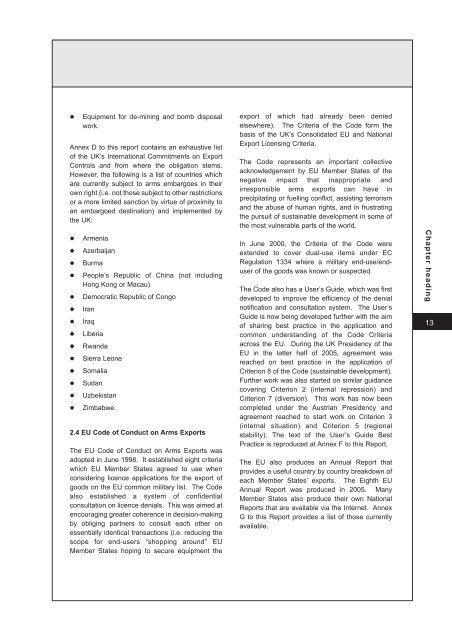Annex A - Official Documents
Annex A - Official Documents
Annex A - Official Documents
You also want an ePaper? Increase the reach of your titles
YUMPU automatically turns print PDFs into web optimized ePapers that Google loves.
� Equipment for de-mining and bomb disposal<br />
work.<br />
<strong>Annex</strong> D to this report contains an exhaustive list<br />
of the UK’s International Commitments on Export<br />
Controls and from where the obligation stems.<br />
However, the following is a list of countries which<br />
are currently subject to arms embargoes in their<br />
own right (i.e. not those subject to other restrictions<br />
or a more limited sanction by virtue of proximity to<br />
an embargoed destination) and implemented by<br />
the UK:<br />
� Armenia<br />
� Azerbaijan<br />
� Burma<br />
� People’s Republic of China (not including<br />
Hong Kong or Macau)<br />
� Democratic Republic of Congo<br />
� Iran<br />
� Iraq<br />
� Liberia<br />
� Rwanda<br />
� Sierra Leone<br />
� Somalia<br />
� Sudan<br />
� Uzbekistan<br />
� Zimbabwe.<br />
2.4 EU Code of Conduct on Arms Exports<br />
The EU Code of Conduct on Arms Exports was<br />
adopted in June 1998. It established eight criteria<br />
which EU Member States agreed to use when<br />
considering licence applications for the export of<br />
goods on the EU common military list. The Code<br />
also established a system of confidential<br />
consultation on licence denials. This was aimed at<br />
encouraging greater coherence in decision-making<br />
by obliging partners to consult each other on<br />
essentially identical transactions (i.e. reducing the<br />
scope for end-users “shopping around” EU<br />
Member States hoping to secure equipment the<br />
export of which had already been denied<br />
elsewhere). The Criteria of the Code form the<br />
basis of the UK’s Consolidated EU and National<br />
Export Licensing Criteria.<br />
The Code represents an important collective<br />
acknowledgement by EU Member States of the<br />
negative impact that inappropriate and<br />
irresponsible arms exports can have in<br />
precipitating or fuelling conflict, assisting terrorism<br />
and the abuse of human rights, and in frustrating<br />
the pursuit of sustainable development in some of<br />
the most vulnerable parts of the world.<br />
In June 2000, the Criteria of the Code were<br />
extended to cover dual-use items under EC<br />
Regulation 1334 where a military end-use/enduser<br />
of the goods was known or suspected.<br />
The Code also has a User’s Guide, which was first<br />
developed to improve the efficiency of the denial<br />
notification and consultation system. The User’s<br />
Guide is now being developed further with the aim<br />
of sharing best practice in the application and<br />
common understanding of the Code Criteria<br />
across the EU. During the UK Presidency of the<br />
EU in the latter half of 2005, agreement was<br />
reached on best practice in the application of<br />
Criterion 8 of the Code (sustainable development).<br />
Further work was also started on similar guidance<br />
covering Criterion 2 (internal repression) and<br />
Criterion 7 (diversion). This work has now been<br />
completed under the Austrian Presidency and<br />
agreement reached to start work on Criterion 3<br />
(internal situation) and Criterion 5 (regional<br />
stability). The text of the User’s Guide Best<br />
Practice is reproduced at <strong>Annex</strong> F to this Report.<br />
The EU also produces an Annual Report that<br />
provides a useful country by country breakdown of<br />
each Member States’ exports. The Eighth EU<br />
Annual Report was produced in 2005. Many<br />
Member States also produce their own National<br />
Reports that are available via the Internet. <strong>Annex</strong><br />
G to this Report provides a list of those currently<br />
available.<br />
Chapter heading<br />
13

















